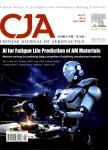A trajectory planning method on error compensation of residual height for aero-engine blades of robotic belt grinding
A trajectory planning method on error compensation of residual height for aero-engine blades of robotic belt grinding作者机构:State Key Laboratory of Mechanical TransmissionChongqing UniversityChongqing 400044China
出 版 物:《Chinese Journal of Aeronautics》 (中国航空学报(英文版))
年 卷 期:2022年第35卷第4期
页 面:508-520页
核心收录:
学科分类:080503[工学-材料加工工程] 08[工学] 082503[工学-航空宇航制造工程] 0805[工学-材料科学与工程(可授工学、理学学位)] 0802[工学-机械工程] 0825[工学-航空宇航科学与技术] 080201[工学-机械制造及其自动化]
基 金:supported by the National Natural Science Foundation of China(No.52075059) the Natural Science Foundation of Chongqing(No.cstc2020jcyj-msxm X0266)
主 题:Aero-engine blade Double-vector controlling Interpolation algorithm Residual height error Robotic grinding
摘 要:While the traditional trajectory planning methods are used in robotic belt grinding of blades with an uneven machining allowance distribution, it is hard to obtain the preferable profile accuracy and surface quality to meet the high-performance requirements of aero-engine. To solve this problem, a novel trajectory planning method is proposed in this paper by considering the developed interpolation algorithm and the machining allowance threshold. The residual height error obtained from grinding experiments of titanium alloy sample was compensated to modify the calculation model of row spacing, and a new geometric algorithm was presented to dynamically calculate the cutter contact points based on this revised calculation model and the dichotomy method. Subsequently, the off-line machining program is generated based on a double-vector controlling method to obtain an optimal contact posture. On this basis, three sets of robotic grinding tests of titanium alloy blades were conducted to investigate the advantages of the proposed *** comparative experimental results revealed that the presented algorithm had improved the surface profile accuracy of blade by 34.2% and 55.1%, respectively. Moreover, the average machined surface roughness was achieved to 0.3 μm and the machining efficiency was obviously promoted. It is concluded that this research work is beneficial to comprehensively improve the machined quality of blades in robotic belt grinding.



